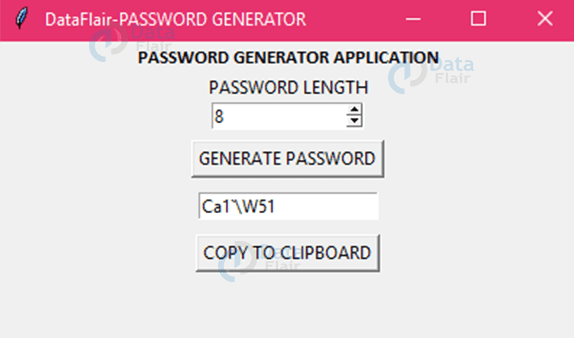
Learn how to create a random password generator in Python.
We know that passwords are a real security threat. To keep your account safe and prevent your password from being hacked you have to make your password hard enough that nobody can guess.
Password Generator
It is a tool that generates passwords based on the given guidelines that you set to create an unpredictable strong password for your accounts.
The Password generator tool creates a random and customized password for users that helps them to create a strong password that provides greater security.
Password Generator Python Project
The objective of this project is to create a password generator using python. The password generator project will be build using python modules like Tkinter, random, string, pyperclip.
In this project, the user has to select the password length and then click on the “Generate Password” button. It will show the generated password below. If the user clicks on the “Copy To Clipboard” button, then it will copy the password automatically.
Project Prerequisites
To build this project we will use the basic concept of python and libraries – Tkinter, pyperclip, random, string.
- Tkinter is a standard GUI library and is one of the easiest ways to build a GUI application.
- pyperclip module allows us to copy and paste text to and from the clipboard to your computer
- The random module can generate random numbers
- string module contains a number of functions to process the standard python string.
To install the libraries we can use pip installer from the command line:
pip install tkinter
pip install pyperclip
pip install random
pip install stringsDownload Project Code
Download the source code of the password generator project: Python Password Generator
Project File Structure
Let’s check the step to build a Password Generator using Python
- Import modules
- Initialized Window
- Select Password Length
- Define Functions
Steps to create random password generator
1. Import Libraries
The first step is to import libraries
from tkinter import *
import random, string
import pyperclip2. Initialize Window
root = Tk()
root.geometry("400x400")
root.resizable(0,0)
root.title("DataFlair - PASSWORD GENERATOR")- Tk() initialized tkinter which means window created
- geometry() set the width and height of the window
- resizable(0,0) set the fixed size of the window
- title() set the title of the window
Label(root, text = 'PASSWORD GENERATOR' , font ='arial 15 bold').pack()
Label(root, text ='DataFlair', font ='arial 15 bold').pack(side = BOTTOM)Label() widget used to display one or more than one line of text that users can’t able to modify.
- root is the name which we refer to our window
- text which we display on the label
- font in which the text is written
- pack organized widget in block
3. Select Password Length
pass_label = Label(root, text = 'PASSWORD LENGTH', font = 'arial 10 bold').pack()
pass_len = IntVar()
length = Spinbox(root, from_ = 8, to_ = 32 , textvariable = pass_len , width = 15).pack()- pass_len is an integer type variable that stores the length of a password.
- To select the password length we use Spinbox() widget.
- Spinbox() widget is used to select from a fixed number of values. Here the value from 8 to 32
4. Function to Generate Password
pass_str = StringVar()
def Generator():
password = ''
for x in range (0,4):
password = random.choice(string.ascii_uppercase) + random.choice(string.ascii_lowercase) + random.choice(string.digits) + random.choice(string.punctuation)
for y in range(pass_len.get()- 4):
password = password + random.choice(string.ascii_uppercase + string.ascii_lowercase + string.digits + string.punctuation)
pass_str.set(password)- pass_str is a string type variable that stores the generated password
- password = “” is the empty string
- First loop will generate a string of length 4 which is a combination of an uppercase letter, a lowercase letter, digits, and a special symbol and that string will store in password variable.
- The second loop will generate a random string of length entered by the user – 4 and add to the password variable. Here we minus 4 to the length of the user because we already generate the string of length 4.
We have done this because we want a password that must contain an uppercase, a lowercase, a digit, and a special symbol.
Now the password is set to the pass_str() variable.
Button(root, text = "GENERATE PASSWORD" , command = Generator ).pack(pady= 5)
Entry(root , textvariable = pass_str).pack()- Button() widget used to display button on our window
- command is called when the button is click
- Entry() widget used to create an input text field
- textvariable used to retrieve the current text to the entry widget
5. Function to Copy Password
def Copy_password():
pyperclip.copy(pass_str.get())
Button(root, text = 'COPY TO CLIPBOARD', command = Copy_password).pack(pady=5)pyperclip.copy() used to copy the text to clipboard
Python Password Generator Output

